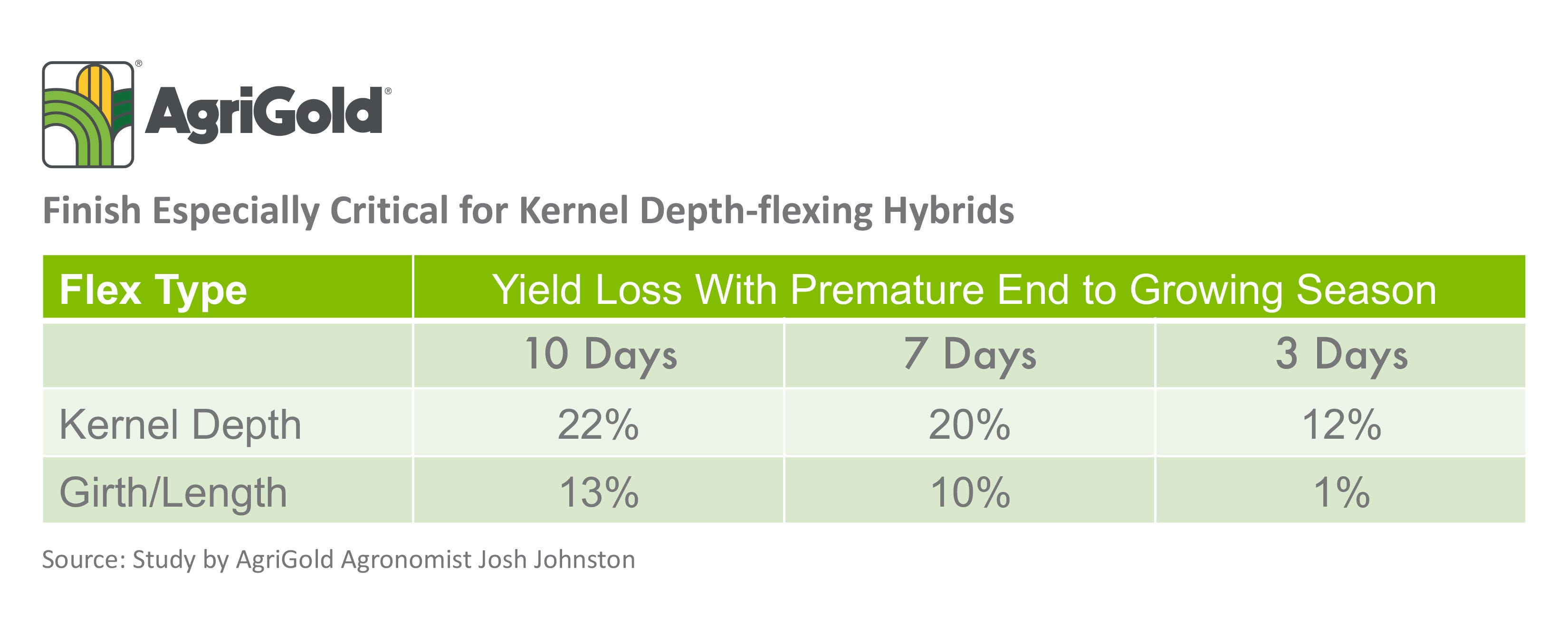February 23, 2024

AgriGold defines ear flex in a unique way, telling farmers how hybrids flex their ear — by girth, length or kernel depth. “We do that because knowing how ears flex helps farmers manage the product better,” explains AgriGold Agronomist Kevin Gale. “Whether it’s fertilizer placement, seeding populations or fungicide use, those management decisions should be catered to ear-flex type.
“Today’s farmers want information they can use to better manage the products they plant and increase yields,” Gale says. “Flex type gives them more insight on how to optimally manage their hybrids and boost their return on investment.”
Ear flex type: Girth
For hybrids that flex by girth (kernels around), that key “piña colada” period is around the V5 growth stage. A common threat at that point is cool, wet soils — conditions that can make it difficult for the corn plant to take up nutrition.
“Early-season fertility is a really big player for girth-flexing hybrids,” Johnston says. “A good starter fertilizer can function like an IV for the plant, feeding it the nutrition it needs and positively impacting girth,” he continues. If weather is especially poor heading into that critical girth-setting stage, it may be worth trying a foliar feed.
Hybrids that flex by girth typically don’t have as long of an ear, so those products may have a yield response when seeded at higher planting populations, according to Gale.
Ear flex type: Length
Effective management of length-flexing hybrids requires planning ahead since the height of the crop at midseason limits application options. “Think through what you can do to build the plant factory up,” Johnston recommends. “If that factory isn’t strong heading into the tasseling timeframe, you’ll leave bushels on the table. But if the plant is well fertilized and actively growing, it should be able to overcome periods of stressful weather.”
Assess how much nutrition the crop will need and how it should be placed, Johnston says. “Think of your fertility strategy as a baton race, making sure there are no gaps in application coverage,” he advises. Johnston also encourages farmers to be on alert for foliar disease and perhaps consider a Y-drop or foliar fertilizer application for high-yield zones during the V12 to V14 timeframe.
Length-flexing hybrids typically don’t like in-row competition, Gale points out, adding they perform well in the West where lower populations are the norm. “They also do well under irrigation,” he adds. If a length-flexing hybrid does encounter stress immediately after pollination, kernels on the tip of the ear can abort, resulting in a nose on the tip of the ear.
Ear flex type: Kernel depth
Late-season availability of water and nutrients along with plant health influence kernel flex, Gale says. “Kernel-depth products have the highest potential to respond to two applications of fungicide if the environment is conducive to disease development.”
In addition to making sure plants have what they need to thrive all the way to black layer, farmers need to focus on keeping season-ending diseases like Goss’s wilt, southern rust and
at bay, Johnston adds. He has conducted studies showing that a premature death of three days can cost farmers up to 12% in yield.
“Farmers’ No. 1 strategy with kernel flex hybrids should be using a high-quality fungicide to preserve your yield potential,” Johnston says. “From there, adding boron and other micronutrients can make those kernels even heavier.”
Many hybrids on the market today fall into the kernel-depth flex type, a shift from previous decades. “These kernel flex hybrids might not look the best on Aug. 1, but they pack on the yield late in the season,” Gale explains.
“Farmers should start by picking the right genetics for a given acre, and then adjust their management strategy to that hybrid,” Gale says. “This ear flex piece is one more piece of the puzzle farmers can use to maximize their performance in the field.”
Source: AgriGold

(Source: Agrigold) With kernel-flex hybrids, grain fill is especially critical to big yields. Josh Johnston’s studies show that a premature death of even three days can cost farmers up to 12% of yield with this flex type.
You May Also Like




